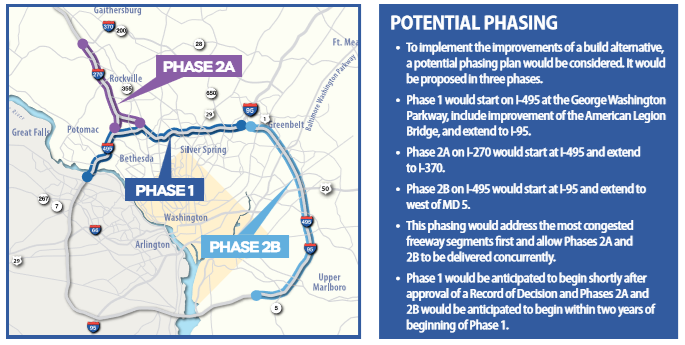MD okayed Hogan’s bad highway-widening plan but delayed the Beltway portion
_approaching_Exit_27_(Interstate_95)_in_Adelphi,_Prince_Georges_County,_Maryland_800_600_90.jpg)
The Beltway in Adelphi, Prince George’s County by Famartin licensed under Creative Commons.
In a last-minute change to assuage critics in early June, the Maryland Board of Public Works (BPW) approved the use of private companies to widen the Beltway and I-270 with toll lanes, but changed the order of how the project will be rolled out. The “compromise” delays work on the Beltway following a backlash from residents, and starts with widening I-270 instead. It doesn’t address financial concerns about privately-managed toll lanes, nor the project’s destructive environmental impacts.
Maryland Governor Larry Hogan and Comptroller Peter Franchot voted for the public-private partnership (P3), while Treasurer Nancy Kopp voted against it. She cited both broad concerns about whether road-widening is a good way to address congestion, and lack of clarity on the details of the switch. “Can we see in writing what was voted on?” she asked at the meeting on June 5 after the vote was taken.
As Monday’s record-setting storm illustrated, roadways can become dangerous conduits in heavy rain. In tomorrow’s post, I’ll discuss more of why increasing the amount of impervious surfaces is such a bad idea. First, here’s an update on what happened at the BPW meeting.
A compromise and other surprises
My organization, Audubon Naturalist Society, joined speakers from the Sierra Club, Citizens Against Beltway Expansion, Corazón Latino, Maryland Transit Opportunities Coalition, Central Maryland Transportation Alliance, and Montgomery, Charles, and Frederick County officials at a press conference in Annapolis before the vote. Our pressure, and all of yours, helped push the BPW towards this compromise outcome that slows down the P3 process.
The Maryland Department of Transportation (MDOT) State Highway Administration originally planned to design and construct the project in three stages. Phase 1 would have been the Montgomery County portion of the Beltway, including the American Legion Bridge; Phase 2A would have been I-270 from the Beltway to I-370; and Phase 2B would have included the Prince George’s County portion of the Beltway to west of MD-5.
Figure 1: Original phasing plan for the highway widening segments prior to the June 5th vote. 
Franchot said switching the order of phases 1 and 2A will give the state an opportunity to consider some of the concerns Montgomery County officials and residents raised. Hogan said, “I’m moving forward with 270 because more people want to do 270.”
While Montgomery County officials cheered this element of the decision, what they ultimately want is a solution for I-270 north of I-370 up to Frederick, where traffic bottlenecks at every rush hour. However, it seems that the state will not actually work on the northern portion of I-270, only the southern portion already planned for. The American Legion Bridge, considered by many to be the worst traffic choke point in the region, will stay with the Beltway portion in Phase 2.
In Prince George’s County, the SHA study ends well before the Woodrow Wilson Bridge, leaving it up to the Virginia Department of Transportation for some reason to determine how to handle the Maryland approach to the Potomac.
In another surprise, Franchot proposed four new amendments as conditions for the project to move forward:
- Allow buses to use the toll lanes for free, though Transportation Secretary Pete Rahn had already committed do doing this.
- Allot 10% of the state’s share of any toll revenue to transit in Montgomery and Prince George’s counties. This might not be very much; the goal of these P3 road companies is to maximize toll revenue and profits for themselves, not send money to the state.
- Study the feasibility of a monorail along I-270.
- Require Board of Public Works approval of a final contract before the state buys any private properties via eminent domain.
A predetermined outcome
Many details still need to be worked out, but the vote gives MDOT the authority to vet vendors for the project. However, the Draft Environmental Impact Statement (EIS), which includes alternatives for the project, won’t be complete until late 2019 or early 2020.
The alternatives analysis is the heart of any National Environmental Policy Act (NEPA) review, which is designed to “assure that all branches of government give proper consideration to the environment prior to undertaking any major federal action that significantly affects the environment.” The alternatives analysis is defined by the Purpose and Need of the project, which sets the range in which “reasonable alternatives” must be considered.
For this project, the first item in MDOT’s Purpose and Need is “Accommodate Existing Traffic and Long-Term Traffic Growth.” The third is “Provide Additional Roadway Travel Choices.” There is no mention of reducing contributions to greenhouse gas emissions from the transportation sector, which would have changed the scope of what is considered “reasonable.”
The state says it has no money to dedicate to this project, and therefore all investment must come from the private sector. No transit alternatives have been retained in the study at this point, so no serious transit alternative will be analyzed in the EIS.
The state is essentially saying: “the purpose of this federal project is to build toll lanes that will provide revenue to the private sector and a faster car-based commute to those that can afford it.” With a goal like that, there’s little room for negotiation and creative ideas to improve transportation holistically.
